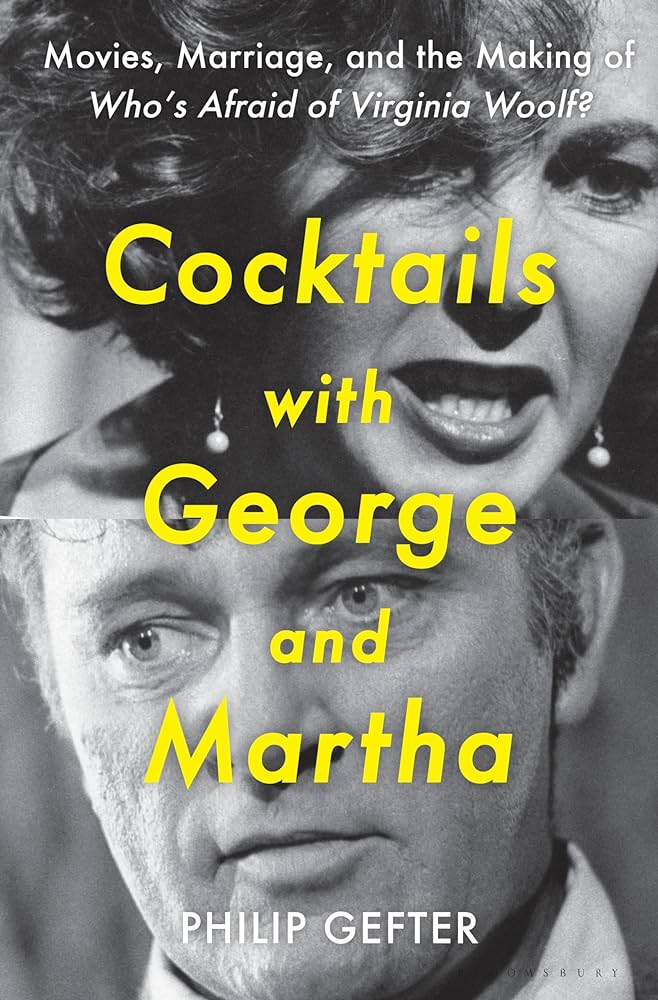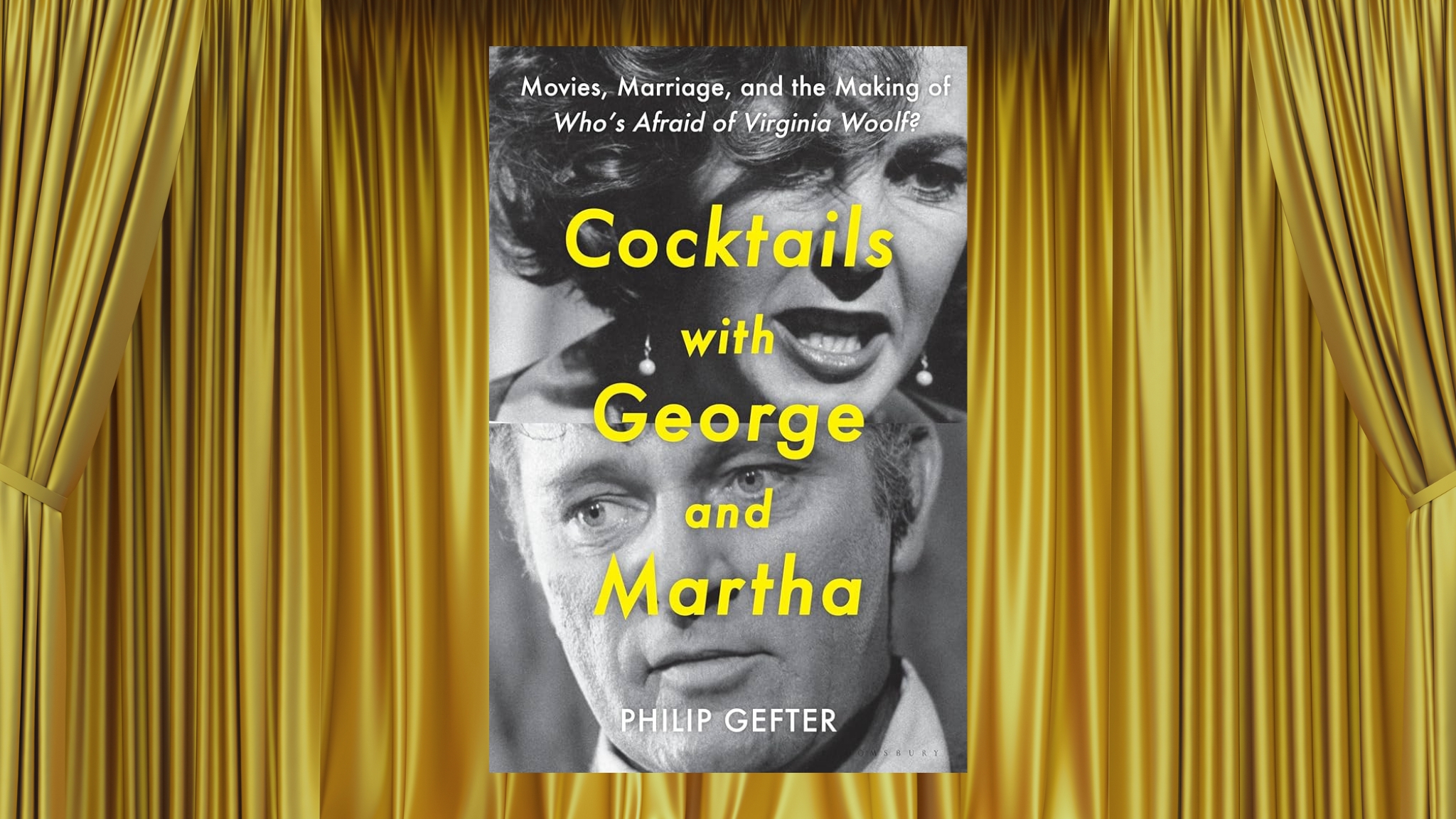Cocktails with George and Martha by Philip Gefter
What's It About?
An award-winning writer reveals the behind-the-scenes story of the provocative play, the groundbreaking film it became, and how two iconic stars changed the image of marriage forever.Author Philip Gefter has written a gossipy sparkler of a book not to be missed by theater fans and movie buffs called Cocktails with George and Martha, subtitled Movies, Marriage, and the Making of Who’s Afraid of Virginia Woolf? (Bloomsbury Publishing). This work of nonfiction, in the words of Cole Porter “it’s delightful, it’s delicious, it’s de-lovely”. Although far less discomfiting by today’s standards, Edward Albee’s play was outrageously shocking, profane, provocative, original and highly controversial when it debuted on Broadway.
The film version was shortened by an hour with cursing reduced as well as toned down and yet still barely skated past the censors and the National Roman Catholic League of Decency. The title certainly suggests a far tamer invitation than what awaits guests Honey and Nick at a private late-night faculty after-party at the home of hosts George and Martha.
Philip Gefter is a one-man Greek Chorus providing scintillating discussion and commentary on the inception, production, reception and principal players who brought the now iconic and most successful of Albee’s works to stage and screen. His biographical sketches contribute valuable insights and depth to his revelations in a most entertaining manner.
The Play’s Debut and History of the Playwright
Playwright Edward Franklin Albee III (1928-2016) was adopted at the age of two weeks by Reed and Frances Albee, an immensely wealthy couple, who in hindsight seemed to have been singularly ill-suited for parenthood. Adopted son Edward contended he was not well-suited for childhood either.
They owned his and her Rolls Royce automobiles, an estate in Larchmont, NY suitable for entertaining and close enough to Manhattan for the family to regularly attend the theater and other events. His adoptive grandfather began as a circus roustabout for P.T. Barnum before becoming a vaudeville impresario partnering with Benjamin Franklin Keith to form the legendary and lucrative Keith-Albee-Orpheum circuit of theatres which also became the first to show motion picture features in the USA. Albee additionally controlled theatrical bookings through The Vaudeville Manager’s Association garnering commissions from every act booked.
In 1928, his company was purchased by Radio Corporation of America which spawned RKO Pictures. He died when his adoptive grandson was two, having left him with a liberating, career-launching legacy of $100,000 distributed when Edward attained his 21st birthday.
After a repressive, albeit privileged, childhood that included expulsions from several prestigious schools as well as Trinity College (the latter for failing to attend compulsory chapel), Edward Albee left home permanently in his late teens. His relationship with his mother was particularly difficult in view of her homophobia often displayed in virulent, pointed barbs. This precociously bright young man had already shown great promise as a writer, for by age 18 he had written and published several poems, short stories, and essays, as well as an unpublished novel.
After leaving home, Edward Albee moved to Greenwich Village where he lived, loved and worked odd jobs while writing. The Zoo Story, a one-act play, was first performed in Berlin in late September, 1959 on a bill with Samuel Beckett’s Krapp’s Last Tape. Both productions were recast and opened way Off-Broadway at Provincetown Playhouse on January 14, 1960 and ran until May 21, 1961. The play won two OBIE awards in 1960 for Distinguished Play and for Distinguished Performance for actor William Daniels.
Several critics promptly labeled Albee as a dramatist for the Theatre of the Absurd, although he contended he was actually an observer who wrote about the human condition, marriages and relationships. However one may choose to categorize his plays, Edward Albee’s career was fully and successfully launched by The Zoo Story.
During his lifetime, he received many honors and awards including three Pulitzer Prizes for Drama, three Tony Awards including one for Lifetime Achievement and three Drama Desk Awards.
A Dive into Marriage and the Human Condition
Who’s Afraid of Virginia Woolf?; Edward Albee’s first full-length three-act play to debut on Broadway, opens with three words, “What a dump!”, spoken emphatically by Martha. This was a direct reference to a line derisively delivered by Bette Davis to Joseph Cotten in the otherwise rather forgettable noir film Beyond the Forest.
Passive-aggressive husband George doesn’t rise to the bait and refuses to acknowledge the gibe or his tipsy wife. Philip Gefter states, “They are a proclamation and a provocation….a strand of DNA that will replicate and mutate and evolve throughout a nocturnal odyssey of taunts and dares, with its own thunderous crescendos and touching adagio.”
Who’s Afraid of Virginia Woolf? is set on the campus of a small, unnamed, fictional New England college in the living room of a faculty home. George and Martha are a middle-aged couple, graying and slumped from years of disillusionment acquired through their long marriage and his perpetually derided failures, career and otherwise.
He remains an associate professor without original published works to his credit, a disappointment to Martha whose father is the college president and éminence grise who hired him. At 2:00 a.m., after a party to welcome new faculty, attracted by the handsome new biology professor Martha impetuously invites him and his drab, wallflower wife home for yet more cocktails.
Verbal volleys, loud arguments, a tawdry attempt at seduction, confessions betrayed and outright lies both engage and stun the young couple who may fear the brutal public display of this dysfunctional marriage behind closed doors may permeate their own hasty marriage. The audience is riveted to their seats for three and a half hours of searing drama (mercifully interrupted by two ten-minute intermissions) by powerful performances and conceivably to examine their own relationships.
As film director Mike Nichols later stated the drama “occurred between moonlight and sunrise.” One concludes George and Martha do love each other in a crazy, emotionally violent sort of unity but the same may not be true for Nick and Honey; the witnesses, observers and unwitting participants in their contentious games. Come for cocktails, leave eviscerated.
Reception, Cast, Broadway Run and Nominations
The play was certainly never anticipated as a sure-fire success. It requires two strong, deeply talented and equally matched actors for George and Martha in roles that are both powerful and emotionally draining. As a consequence, the original Broadway production had a separate cast for matinee performances.
Securing financing was initially difficult and required the playwright and producers to invest $10,000 each of their own money. Production costs came in at less than $50,000, lower than estimated, with investors repaid within 30 days and tremendous profits reaped.
It’s interesting to note that the line Who’s Afraid of Virginia Woolf? is sung as a taunting nursery rhyme at various times during the production to the tune of Here We Go Round the Mulberry Bush rather than Who’s Afraid of the Big Bad Wolf from the 1933 Disney Silly Symphony cartoon Three Little Pigs, as it was in the public domain and hence royalty-free resulting in additional savings.
The play opened at the Billy Rose Theatre, seating capacity 1232, (currently named Nederlander Theatre) on October 13, 1962 after five previews and ran for 664 sold-out performances and closed on May 16, 1964. The cast was comprised of Uta Hagen as Martha, Arthur Hill as George, Melinda Dillon (Ralphie’s mom in 1983’s A Christmas Story) in her Broadway debut, and George Grizzard as Nick.
The 1963 Tony Awards® were dominated by the play with five awarded for Best Play, Best Actor Arthur Hill, Best Actress Uta Hagen, Best Direction Alan Schneider and Best Producers Richard Barr and Clinton Wilder. Melinda Dillon was nominated but lost to Sandy Dennis in A Thousand Clowns. Melinda did receive the Theatre World Award for Best Featured Actress but Sandy Dennis was cast as Honey in the 1966 film adaptation and won the coveted Academy Award for Best Supporting Actress.
London soon mounted a long West End run while Ingmar Bergman directed a production in Sweden. The drama has become an iconic staple: revived several times on Broadway with multiple national, regional and international companies as well as innumerable performances on college and university stages.
Adaptation Into a Star-Studded Film
Mike Nichols, hit improvisational sketch comic (Nichols and May) and successful theatre director, was chosen to make his directorial debut on celluloid with the ground-breaking film. The inspired casting of Richard Burton and Elizabeth Taylor added tremendous star power to the production with its attendant prospect of heightened box office returns.
Recently wed after a tabloid-fueled public affair and resultant tumultuous divorces, they were then at the apex of their careers. Elizabeth, age 33, was patently too beautiful and much too young for the part of dumpy Martha but she gamely gained weight and somewhat less willingly aged up through the marvels of wigs and makeup.
Later becoming widely known as the “Battling Burtons”, very much in the vein of the characters they brought to life on camera, at this time the couple were still in their adoring honeymoon phase. Brilliant stage actor Richard Burton greatly assisted his bride in owning the role. They were accorded all the privileges of superstars with reduced working hours, splendidly outfitted separate dressing rooms stocked with fine champagne, favorite foods and lavish gifts including jewelry. Mike Nichols went full “Hollywood” taking up residence in a home that had belonged to the recently deceased Cole Porter and driving a newly acquired Rolls Royce.
Getting the movie made was fraught with difficulties which while entertaining to the reader were clearly a nightmare for the producer. Despotic studio boss Jack Warner pressed for the film to be shot in color until the day before shooting began. There were numerous firings and last minute replacements for vital crew members and various delays that helped drive costs two million over budget. Language including “hump the hostess” and some relatively mild profanity new for general audience cinema as well as the subject matter heightened concerns about the success of the project.
The film adaptation of Who’s Afraid of Virginia Woolf? became an audience, box office and critical success ultimately leading to selection by the Library of Congress in 2013 for preservation in the United States National Film Registry. It was nominated for 13 Academy Awards including Best Picture and Best Director and won five: Elizabeth Taylor and Sandy Dennis for acting and for Best Cinematography, Art Direction and Costume Design. Richard Burton lost to Paul Scofield in A Man for All Seasons and George Segal to Walter Matthau in The Fortune Cookie.
Explores a Legendary Piece of Theater
Recounting the many and varied trials and tribulations of getting the play to opening night and the film to a lavish premiere we leave to the reader to experience in full enjoyment of the author’s wit, observations and insider anecdotes retold with great verve and style. Philip Gefter concludes this thoroughly researched backstage story of the creation of Edward Albee’s greatest work with an epilogue on marriage as well as notes and an extensive bibliography. A selection of black and white photographs is also included.
Cocktails with George and Martha evokes images of grand cocktail parties of the 50s and 60s with tuxedo-clad bartenders pouring chilled bottles of the finest champagne and wines, mixing ice-cold martinis and sidecars. Philip Gefter stands in the center of the film and theater crowd, the host with the most, the raconteur relating tale after amusing tale with quiet discourses on marriage delivered on the side.
This unflinching examination of the creation and execution of a theatrically legendary play as well as movie provides the reader with a great deal more than just a glimpse backstage and offers insights into the personalities of those involved. This grand book provides an invitation not to be missed nor soon forgotten.
About Philip Gefter:

Photo Credit: Patrick McMullan
Philip Gefter is the author of Cocktails with George and Martha: Movies, Marriage and the Making of Who’s Afraid of Virginia Woolf? (Bloomsbury); two biographies: What Becomes a Legend Most: The Biography of Richard Avedon, (Harper) and Wagstaff: Before and After Mapplethorpe, (Liveright) which received the 2014 Marfield Prize for national arts writing; and a collection of essays, Photography After Frank (Aperture). He was an editor at The New York Times for over fifteen years and wrote about photography for the paper. He was the photography critic for the Daily Beast in its early years and contributes frequently to The New Yorker: Photobooth and Aperture, the quarterly of photography. He produced the award-winning documentary, Bill Cunningham New York. He resides in New York City.





